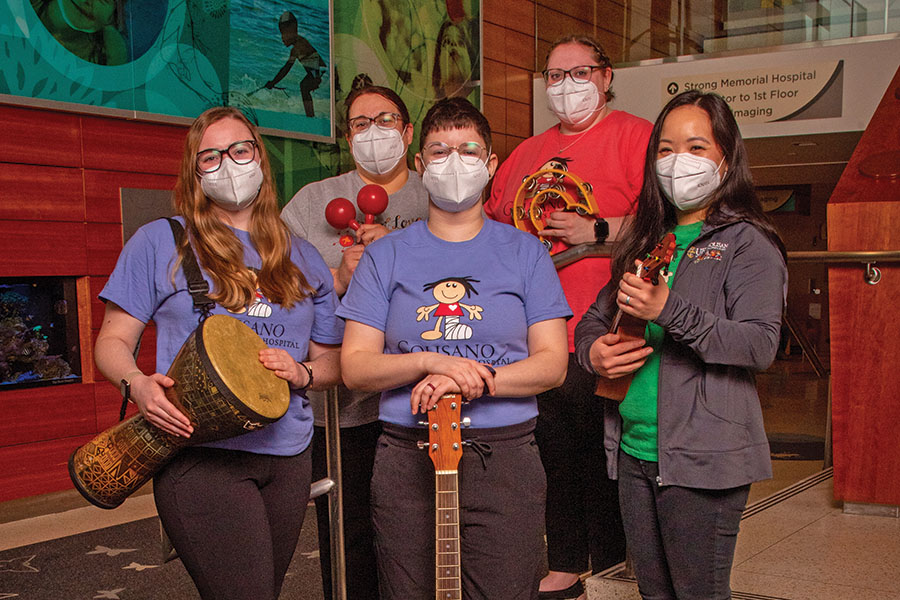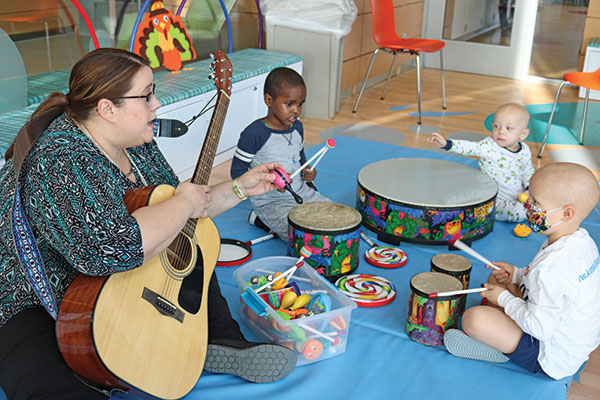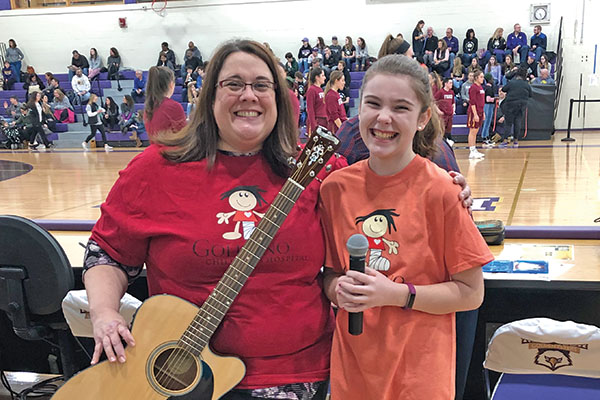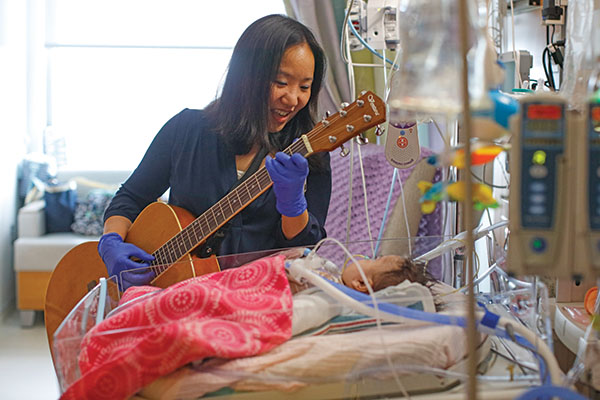LEARNING BY DOING
The Sounds of Solace
Music therapy offers patients comfort and connection.
by Joanie Eppinga and Eamonn Neff

The music therapy team at Golisano Children's Hospital is a Naz family. From left to right: Madison Grimaldi ’21 (intern), Rosemary (Rosie) Obi ’10G, Madeline Mitchell ’20, Kaylee Gray ’21 (intern), and Elaine Kong ’11 pose at the hospital in Rochester, New York, in 2022.
“Music heals,” says Bryan Hunter, a music therapy faculty member at Nazareth College from 1982 to 2020. “That idea is very old — it goes back at least to the Greeks.”
It’s a notion that has been revitalized in the last 70 years, which is how long music therapy has existed as a profession, says Hunter, who started the music therapy program at University of Rochester Medicine’s Golisano Children’s Hospital in 1997. But what exactly does a music therapist do?
In the course of a day, a music therapist might help a patient select an instrument to play or write a song, or review current research. The belief that music can help with pain relief, focus, expression of feelings, and more has increasingly been codified, and Nazareth offers both an undergraduate and a graduate music therapy degree — and in 2022 begins a music therapy equivalency certificate as well.
Students are drawn to the blend of music and mental health and to Nazareth's "vibrant department," says Melissa Reed ’01, ’06G, an assistant clinical professor in music therapy. “Our students contribute to our community every day, working in nursing homes, schools, and other clinical settings."
The students receive rigorous training. Becoming a Music Therapist – Board Certified (MT-BC) involves first getting a degree by taking classes in music fundamentals, the life sciences, psychology, and several instruments, coupled with clinical placements under supervision. Then comes a six-month full-time internship, followed by a three-hour board exam that covers musical concepts, case scenarios, clinical applications, and research in the field.
Their thorough training is important to music therapists, says Rosemary (Rosie) Obi ’10G, an inpatient music therapist at Golisano Children’s Hospital who earned her master’s degree in music therapy from Nazareth in 2010. The first music therapist at Golisano, Obi developed the program over the past 21 years, in which time it has trained more than 70 Nazareth practicum students and interns. Obi says that the profession’s evidence-based nature confers credibility, so she wants people to know that music therapy is based on science.
“When I first tell people I’m a music therapist,” Obi says, “they often say, ‘That’s so nice.’ And it is nice! It’s a wonderful career, and I love it! But it’s also a hard career, and it has value beyond niceness.”
Research supports Obi’s assessment, with both qualitative and quantitative studies showing the value of music therapy. Hunter explains that music “organizes the neural response” and involves both sides of the brain. “Music helps relax people,” he says. “We can apply that finding systematically to those with high anxiety or in distressing situations.”
Therapists emphasize that patients don’t need to have musical inclination or talent to benefit from music therapy. “You don’t have to be a musician to receive it,” says Madison Grimaldi ’21, currently an intern at Golisano. “Evidence shows that it provides benefits even if a patient just listens.”
One such benefit, Hunter notes, is that music therapy can alleviate pain. He says that Obi headed a music therapy study for children who received painful injections to help them with muscle spasticity. “She’d sing to them,” Hunter says, “and get them to sing through the procedure — and they were hardly aware that they were getting those shots.”
Elaine Kong ’11, another music therapist at Golisano, agrees. “We’re using music strategically for a non-music goal: to help patients stabilize their physiological state and decrease pain,” she says.
Kong began at the hospital six years ago as a part-timer, and then expanded her work to the neonatal and pediatric intensive care units. Now, thanks partly to funding provided by donations from The Battle of the Beaks, Nazareth’s annual basketball competition with St. John Fisher, services have been expanded, more Nazareth interns work with patients, and Kong works full-time to assist patients.
One such patient is Emily Lokken, a teenager who has been receiving music therapy since she was a toddler. Emily’s mother, Sarah Lokken, says of the treatment, “I’ve seen it take my child from needing expensive pain medication to being able to do procedures just by having the music therapist in the room with her.
“I’m sold on it!”
Emily’s enthusiasm for music therapy is similarly evident. “I like singing songs and getting my mood out,” she says. “What I like most is it helps me cope emotionally.”
“Music therapy helps Emily get out what she’s thinking and feeling as the patient,” Lokken says. “She may tell a physician she’s fine, but you might find out through her music that she’s struggling with something — she may not even know it herself. She writes down her feelings, and then she puts it into a song.”
Self-expression is indeed an important element of music therapy, especially for nonverbal people such as stroke victims, those with Alzheimer’s, and pre-verbal children. Music therapists both see patients’ expression of feeling and relate to it. Madeline Mitchell ’20, who completed a music therapy internship at Golisano and was hired on as a full-time music therapist last year, says, “When I’m working with a patient, I feel amazing — just seeing the direct results of what I do feeds my soul.”
One of those results, according to both therapists and patients, is the relationship that forms between them. “Rosie’s like part of our family,” Sarah Lokken says, and Emily concurs: “I feel like I’ve known Rosie my whole life. Our relationship is very strong.”
That bond is important to therapists. “I love the connections I make with my patients,” Grimaldi says. “Seeing patients start to trust you makes it a more meaningful and special experience.” Kaylee Gray ’21, another music therapy intern at Golisano, agrees: “Sometimes we see patients for such a short time,” she says, “but music can bring on those connections and empower patients so quickly.”
Emily says she can’t foresee there ever being a time when she’d want to forgo the empowering benefits of music therapy, and her mother adds, “This therapy has helped Emily develop coping mechanisms that will carry her lifelong.”
There’s a reason that, as Hunter notes, Apollo was the god of both music and medicine. For Golisano patients and their Nazareth-trained music therapists, the combined art and science of music therapy strikes a harmonious and healing chord.
Joanie Eppinga is a freelance writer and editor in Madison, Wisconsin. Eamonn Neff is a freelance writer in Everett, Washington.

Rosemary (Rosie) Obi '10G leads a weekly music therapy group for patients hospitalized at Golisano Children’s Hospital. (The photo was taken before the COVID-19 pandemic.)

Rosemary (Rosie) Obi and music therapy client Emily Lokken sang the national anthem (2019) at Nazareth's Battle of the Beaks, an annual event that has raised $150,000 for Golisano Children's Hospital and particularly music therapy there.

Elaine Kong ’11 works in the neonatal and pediatric intensive care units. (The photo was taken before the COVID-19 pandemic.)